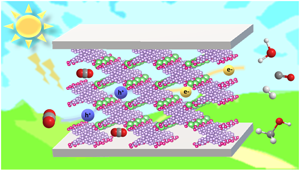Crossref Citations
This article has been cited by the following publications. This list is generated based on data provided by
Crossref.
Fan, Wei Keen
and
Tahir, Muhammad
2021.
Recent trends in developments of active metals and heterogenous materials for catalytic CO2 hydrogenation to renewable methane: A review.
Journal of Environmental Chemical Engineering,
Vol. 9,
Issue. 4,
p.
105460.
Mazari, Shaukat Ali
Hossain, Nazia
Basirun, Wan Jeffrey
Mubarak, Nabisab Mujawar
Abro, Rashid
Sabzoi, Nizamuddin
and
Shah, Asif
2021.
An overview of catalytic conversion of CO2 into fuels and chemicals using metal organic frameworks.
Process Safety and Environmental Protection,
Vol. 149,
Issue. ,
p.
67.
Hao, Leiduan
Xia, Qineng
Zhang, Qiang
Masa, Justus
and
Sun, Zhenyu
2021.
Improving the performance of metal-organic frameworks for thermo-catalytic CO2 conversion: Strategies and perspectives.
Chinese Journal of Catalysis,
Vol. 42,
Issue. 11,
p.
1903.
Braun, Artur
Toth, Rita
and
Erat, Selma
2021.
Solar energy and the circular economy: An introduction.
MRS Energy & Sustainability,
Vol. 8,
Issue. 1,
p.
1.
Boldrin, Maria Valnice
Irikura, Kallyni
Costa e Silva, Beatriz
Cardoso, Juliano Carvalho
Stulp, Simone
Moraes da Silva, Caroline
Frem, Regina Célia Galvão
Candia-Onfray, Christian
Rojas, Susana
and
Salazar, Ricardo
2021.
Metal−Organic Frameworks for Carbon Capture and Energy.
Vol. 1393,
Issue. ,
p.
395.
Yang, Lu
and
Zhou, Zhen
2021.
Metal−Organic Frameworks for Carbon Capture and Energy.
Vol. 1393,
Issue. ,
p.
239.
Isaeva, Vera I.
Timofeeva, Maria N.
Lukoyanov, Ivan A.
Gerasimov, Evgeny Yu.
Panchenko, Valentina N.
Chernyshev, Vladimir V.
Glukhov, Lev M.
and
Kustov, Leonid M.
2022.
Novel MOF catalysts based on calix[4]arene for the synthesis of propylene carbonate from propylene oxide and CO2.
Journal of CO2 Utilization,
Vol. 66,
Issue. ,
p.
102262.
Chen, Yu-Hsiu
Shen, Cheng-Hui
Chang, Tzu-En
Wang, Yi-Ching
Chen, You-Liang
and
Kung, Chung-Wei
2022.
Molybdenum-functionalized metal–organic framework crystals interconnected by carbon nanotubes as negative electrodes for supercapacitors.
MRS Energy & Sustainability,
Vol. 9,
Issue. 2,
p.
332.
Yang, Zilin
Cao, Shuai
Lv, Tingting
Zhang, Guangxun
Guo, Xiaotian
Zhang, Songtao
and
Pang, Huan
2022.
Recent progress in the synthesis of metal-organic-framework-derived carbon materials.
MRS Energy & Sustainability,
Vol. 9,
Issue. 2,
p.
281.
Shrivastav, Vaishali
Mansi
Gupta, Bhavana
Dubey, Prashant
Deep, Akash
Nogala, Wojciech
Shrivastav, Vishal
and
Sundriyal, Shashank
2023.
Recent advances on surface mounted metal-organic frameworks for energy storage and conversion applications: Trends, challenges, and opportunities.
Advances in Colloid and Interface Science,
Vol. 318,
Issue. ,
p.
102967.
Candian Firmino Marcos, Francielle
Fonseca Costa, Maria Jose
L. Catuzo, Gabriel
Angeli de Moraes, Daniel
de Oliveira Junior, Marcos
Mastelaro, Valmor Roberto
Mansur Assaf, José
Giudici, Reinaldo
and
Moreira Assaf, Elisabete
2023.
Supported Cu catalysts on UiO-66 toward enhanced methanol selectivity by CO2 hydrogenation: Effect of Cu loading.
Journal of Catalysis,
Vol. 427,
Issue. ,
p.
115104.
Obeso, Juan L.
Flores, J. Gabriel
Flores, Catalina V.
Huxley, Michael T.
de los Reyes, José Antonio
Peralta, Ricardo A.
Ibarra, Ilich A.
and
Leyva, Carolina
2023.
MOF-based catalysts: insights into the chemical transformation of greenhouse and toxic gases.
Chemical Communications,
Vol. 59,
Issue. 68,
p.
10226.
Köse Yaman, Pelin
Demir, Sevde
Denizaltı, Serpil
Erer, Hakan
and
Yeşilel, Okan Zafer
2024.
A copper(ii) metal–organic framework with 2,2-dimethylglutarate and imidazole ligands: synthesis, characterization and catalytic performance for cycloaddition of CO2 to epoxides.
New Journal of Chemistry,
Vol. 48,
Issue. 4,
p.
1850.






